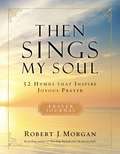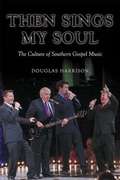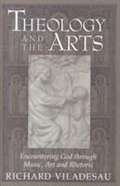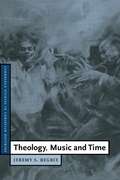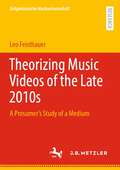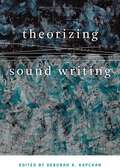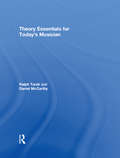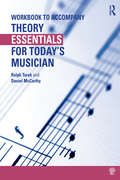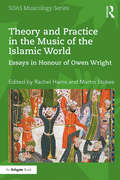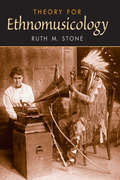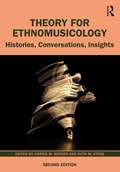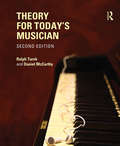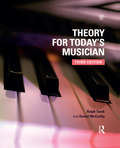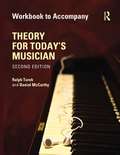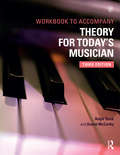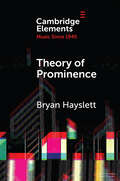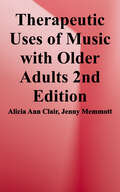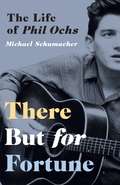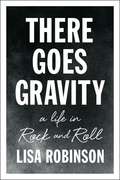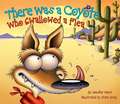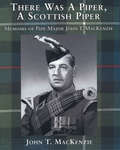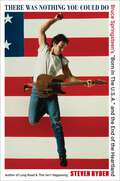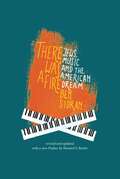- Table View
- List View
Then Sings My Soul: 52 Hymns that Inspire Joyous Prayer
by Robert J. MorganA year of journaling inspiration through the most beloved hymns, based the bestselling Then Sings My Soul series.Pastor Rob Morgan's inimitable style will help people reacquaint themselves with the hymns of the faithful. His goal is to keep these traditional hymns vital and meaningful to all generations. Hymns speak to our soul and add depth and meaning as we worship God through song.This year-long devotional journal shares the emotion behind the hymns of faith that have changed many lives throughout history — not only the people whose faith led them to write these wonderful hymns but also the people whose faith has been transformed by reading, hearing, and singing the songs. Designed to be personally reflective and inspire prayer, each week-long experience allows readers to experience the hymn through:reflection questionsprayer promptsjournaling spacehistoric quotesthe actual hymn with music and lyricsits historical backgroundDraw near to God and deepen your prayer life as you make your way through these 52 hymns that center around the theme of joyous prayer in the Then Sings My Soul Prayer Journal.
Then Sings My Soul: The Culture of Southern Gospel Music (Music in American Life)
by Douglas HarrisonIn this ambitious book on southern gospel music, Douglas Harrison reexamines the music's historical emergence and its function as a modern cultural phenomenon. Rather than a single rhetoric focusing on the afterlife as compensation for worldly sacrifice, Harrison presents southern gospel as a network of interconnected messages that evangelical Christians use to make individual sense of both Protestant theological doctrines and their own lived experiences. Harrison explores how listeners and consumers of southern gospel integrate its lyrics and music into their own religious experience, building up individual--and potentially subversive--meanings beneath a surface of evangelical consensus. Reassessing the contributions of such figures as Aldine Kieffer, James D. Vaughan, and Bill and Gloria Gaither, Then Sings My Soul traces an alternative history of southern gospel in the twentieth century, one that emphasizes the music's interaction with broader shifts in American life beyond the narrow confines of southern gospel's borders. His discussion includes the "gay-gospel paradox"--the experience of non-heterosexuals in gospel music--as a cipher for fundamentalism's conflict with the postmodern world.
Theo Tams: Inside the Music
by Craig McConnellAfter a summer of intense competition, Alberta’s Theo Tams emerged as the 2008 Canadian Idol champion. He had earned the admiration of the public and his fellow contestants with his soaring vocals, emotive piano playing and unmatched ability to mine the emotional core of a song. Theo Tams: Inside the Music is a candid and photo-rich look at the life experiences that prepared him for the Idol stage. It also provides a behind the scenes peek at the Idol experience itself, with testimonials and anecdotes from his fellow competitors and interviews with the Idol personalities. Theo Tams: Inside the Music is the first chapter in the career of an exciting new voice from the Canadian music scene. It includes excerpts from Theo’s private journals, adventures from his time in India, anecdotes from his fellow competitors, interviews with Idol personalities such as Ben Mulroney and Zack Werner, hundreds of candid photos and much, much more.
Theology of the Arts: Encountering God through Music, Art and Rhetoric
by Richard ViladesauThis book explores, in a timely and engaging manner, several aspects of the relations between theology and aesthetics, in both the pastoral and academic realms. The underlying motif of this work is that beauty is a means of divine revelation, and that art is the human mediation that both enables and limits its revelatory power. Although aimed at undergraduate theology students, it will certainly capture the interest of art students, pastoral ministers and anyone who appreciates the arts.
Theology, Music and Time (Cambridge Studies In Christian Doctrine Series #4)
by Jeremy S. BegbieTheology, Music and Time aims to show how music can enrich and advance theology, extending our wisdom about God and God's ways with the world. Instead of asking: what can theology do for music?, it asks: what can music do for theology? Jeremy Begbie argues that music's engagement with time gives the theologian invaluable resources for understanding how it is that God enables us to live 'peaceably' with time as a dimension of the created world. Without assuming any specialist knowledge of music, he explores a wide range of musical phenomena--rhythm, metre, resolution, repetition, improvisation--and through them opens up some of the central themes of the Christian faith -creation, salvation, eschatology, time and eternity, eucharist, election and ecclesiology. In so doing, he shows that music can not only refresh theology with new models, but also release it from damaging habits of thought which have hampered its work in the past.
Theorizing Music Videos of the Late 2010s: A Prosumer’s Study of a Medium (Zeitgenössische Musikwissenschaft)
by Leo FeisthauerThe work formulates a status quo of the music video medium in the late 2010s and shows which trends, aesthetics and (new) standards have established themselves. Particularly the role of the prosumer amidst evolved technical conditions is highlighted in this context, which strongly influences the evolution of music video in this period. Moreover, the author understands music videos as socio-political actors and examines the resulting questions of their interaction with culture.
Theorizing Sound Writing
by Deborah KapchanThe study of listening—aurality—and its relation to writing is the subject of this eclectic edited volume. Theorizing Sound Writing explores the relationship between sound, theory, language, and inscription. This volume contains an impressive lineup of scholars from anthropology, ethnomusicology, musicology, performance, and sound studies. The contributors write about sound in their ongoing work, while also making an intervention into the ethics of academic knowledge, one in which listening is the first step not only in translating sound into words but also in compassionate scholarship.
Theory Essentials for Today's Musician (Textbook): Workbook
by Ralph Turek Daniel McCarthyTheory Essentials for Today’s Musician offers a review of music theory that speaks directly and engagingly to modern students. Rooted in the tested pedagogy of Theory for Today’s Musician, the authors have distilled and reorganized the concepts from the thirty-three chapters of their original textbook into twenty-one succinct, modular chapters that move from the core elements of harmony to further topics in form and 20th-century music. A broad coverage of topics and musicals styles—including examples drawn from popular music—is organized into four key parts: Basic Tools Chromatic Harmony Form and Analysis The 20th Century and Beyond Theory Essentials features clear and jargon-free (yet rigorous) explanations appropriate for students at all levels, ensuring comprehension of concepts that are often confusing or obscure. An accompanying workbook provides corresponding exercises, while a companion website presents streaming audio examples. This concise and reorganized all-in-one package—which can be covered in a single semester for a graduate review, or serve as the backbone for a briefer undergraduate survey—provides a comprehensive, flexible foundation in the vital concepts needed to analyze music. PURCHASING OPTIONS Textbook and Workbook Package (Paperback): 9781138098756 Textbook Only (Hardback): 9781138708815 Textbook Only (Paperback): 9781138708822 Textbook Only (eBook): 9781315201122 Workbook Only (Paperback): 9781138098749 Workbook Only (eBook): 9781315103839
Theory Essentials for Today's Musician (Workbook): Workbook
by Ralph Turek Daniel McCarthyTheory Essentials for Today’s Musician offers a review of music theory that speaks directly and engagingly to modern students. Rooted in the tested pedagogy of Theory for Today’s Musician, the authors have distilled and reorganized the concepts from the thirty-three chapters of their original textbook into twenty-one succinct, modular chapters that move from the core elements of harmony to further topics in form and 20th-century music. A broad coverage of topics and musicals styles—including examples drawn from popular music—is organized into four key parts: Basic Tools Chromatic Harmony Form and Analysis The 20th Century and Beyond Theory Essentials features clear and jargon-free (yet rigorous) explanations appropriate for students at all levels, ensuring comprehension of concepts that are often confusing or obscure. An accompanying workbook provides corresponding exercises, while a companion website presents streaming audio examples. This concise and reorganized all-in-one package—which can be covered in a single semester for a graduate review, or serve as the backbone for a briefer undergraduate survey—provides a comprehensive, flexible foundation in the vital concepts needed to analyze music. PURCHASING OPTIONS Textbook and Workbook Package (Paperback): 9781138098756 Textbook Only (Hardback): 9781138708815 Textbook Only (Paperback): 9781138708822 Textbook Only (eBook): 9781315201122 Workbook Only (Paperback): 9781138098749 Workbook Only (eBook): 9781315103839
Theory and Practice in the Music of the Islamic World: Essays in Honour of Owen Wright (SOAS Musicology Series)
by Rachel Harris Martin StokesThis volume of original essays is dedicated to Owen Wright in recognition of his formative contribution to the study of music in the Islamic Middle East. Wright’s work, which comprises, at the time of writing, six field-defining volumes and countless articles, has reconfigured the relationship between historical musicology and ethnomusicology. No account of the transformation of these fields in recent years can afford to ignore his work. Ranging across the Middle East, Central Asia and North India, this volume brings together historical, philological and ethnographic approaches. The contributors focus on collections of musical notation and song texts, on commercial and ethnographic recordings, on travellers’ reports and descriptions of instruments, on musical institutions and other spaces of musical performance. An introduction provides an overview and critical discussion of Wright’s major publications. The central chapters cover the geographical regions and historical periods addressed in Wright’s publications, with particular emphasis on Ottoman and Timurid legacies. Others discuss music in Greece, Iraq and Iran. Each explores historical continuities and discontinuities, and the constantly changing relationships between music theory and practice. An edited interview with Owen Wright concludes the book and provides a personal assessment of his scholarship and his approach to the history of the music of the Islamic Middle East. Extending the implications of Wright’s own work, this volume argues for an ethnomusicology of the Islamic Middle East in which past and present, text and performance are systematically in dialogue.
Theory for Ethnomusicology
by Ruth M. StoneFor courses in ethnomusicological theory. This book covers ethnomusicological theory, exploring some of the underpinnings of different approaches and analyzing differences and commonalities in these orientations. This text addresses how ethnomusicologists have used and applied these theories in ethnographic research.
Theory for Ethnomusicology: Histories, Conversations, Insights
by Harris M. Berger Ruth M. StoneTheory for Ethnomusicology: Histories, Conversations, Insights, Second Edition, is a foundational work for courses in ethnomusicological theory. The book examines key intellectual movements and topic areas in social and cultural theory, and explores the way they have been taken up in ethnomusicological research. New co-author Harris M. Berger and Ruth M. Stone investigate the discipline’s past, present, and future, reflecting on contemporary concerns while cataloging significant developments since the publication of the first edition in 2008. A dozen contributors approach a broad range of theoretical topics alive in ethnomusicology. Each chapter examines ethnographic and historical works from within ethnomusicology, showcasing the unique contributions scholars in the field have made to wider, transdisciplinary dialogs, while illuminating the field’s relevance and pointing the way toward new horizons of research. New to this edition: Every chapter in the book is completely new, with richer and more comprehensive discussions. New chapters have been added on gender and sexuality, sound and voice studies, performance and critical improvisation studies, and theories of participation. New text boxes and notes make connections among the chapters, emphasizing points of contact and conflict among intellectual movements.
Theory for Today's Musician
by Ralph Turek Daniel McCarthyThe package (ISBN 978-0-415-73036-5) contains the second edition of Theory for Today’s Musician (ISBN: 978-0-415-66332-8) and the Theory for Today’s Musician Workbook (ISBN: 978-0-415-66333-5). The package is available for print books only. Ebook users should purchase the textbook and workbook separately. Theory for Today’s Musician, Second Edition, recasts the scope of the traditional music theory course to meet the demands of the professional music world, in a style that speaks directly and engagingly to today’s music student. It uses classical, folk, popular, and jazz repertoires with clear explanations that link music theory to musical applications. The authors help prepare students by not only exploring how music theory works in art music, but how it functions within modern music, and why this knowledge will help them become better composers, music teachers, performers, and recording engineers. This broadly comprehensive text merges traditional topics such as part-writing and harmony (diatonic, chromatic, neo-tonal and atonal), with less traditional topics such as counterpoint and musical process, and includes the non-traditional topics of popular music songwriting, jazz harmony and the blues. Written by an experienced textbook author and new co-author, both active classroom teachers for many years, Theory for Today’s Musician is the complete and ideal theory text to enable today’s student to accomplish their musical goals tomorrow. New Features to the Second Edition: An expanded unit on form that includes introductory chapters on sonata & rondo, to prepare students for learning form New "Back to Basics" online drills, keyed to the text, allowing students to brush up their fundamentals as needed New musical examples, including over 80 new musical excerpts from both art and popular music repertoires Expanded in-chapter exercises to promote and facilitate classroom interaction Carefully edited in response to market demands to create a more streamlined, flexible text New audio of musical examples (for both text and workbook), 50% re-recorded for improved audio quality An updated and relocated Chapter 33 on song composition in the jazz and popular folk styles, applying principles of text setting, melody composition/harmonization Companion website that houses online tutorial with drills of basic concepts
Theory for Today's Musician Textbook,
by Ralph Turek Daniel McCarthyTheory for Today’s Musician, Third Edition, recasts the scope of the traditional music theory course to meet the demands of the professional music world, in a style that speaks directly and engagingly to today’s music student. It uses classical, folk, popular, and jazz repertoires with clear explanations that link music theory to musical applications. The authors help prepare students by not only exploring how music theory works in art music, but how it functions within modern music, and why this knowledge will help them become better composers, music teachers, performers, and recording engineers. <P><P> This broadly comprehensive text merges traditional topics such as part writing and harmony (diatonic, chromatic, neo-tonal and atonal), with less traditional topics such as counterpoint and musical process, and includes the non-traditional topics of popular music songwriting, jazz harmony and the blues. The accompanying companion website provides interactive exercises that allow students to practice foundational theory skills. Written by experienced authors, both active classroom teachers for many years, Theory for Today’s Musician is the complete and ideal theory text to enable today’s student to accomplish their musical goals tomorrow. Updated and corrected throughout, the Third Edition includes: Expanded coverage of atonality and serialism, now separated into two chapters. Broadened treatment of cadences, including examples from popular music. Substantially rewritten chapter on songwriting. Interactive features of the text simplified to two types, "Concept Checks" and "Review and Reinforcement," for greater ease of use. New and updated musical examples added throughout. Charts, illustrations, and musical examples revised for increased clarity. Audio of musical examples now provided through the companion website. The accompanying Workbook offers exercises and assignments to accompany each chapter in the book. A companion website houses online tutorials with drills of basic concepts, as well as audio.
Theory for Today's Musician Workbook, Second Edition (eBook)
by Ralph Turek Daniel McCarthyThe package (ISBN 978-0-415-73036-5) contains the second edition of Theory for Today’s Musician (ISBN: 978-0-415-66332-8) and the Theory for Today’s Musician Workbook (ISBN: 978-0-415-66333-5). The package is available for print books only. Ebook users should purchase the textbook and workbook separately. This workbook accompanies the second edition of Theory for Today's Musician and is full of exercises to help students practice and master the concepts presented in each chapter. Audio files are included.
Theory for Today's Musician Workbook, Third Edition
by Ralph Turek Daniel McCarthyTheory for Today’s Musician, Third Edition, recasts the scope of the traditional music theory course to meet the demands of the professional music world, in a style that speaks directly and engagingly to today’s music student. It uses classical, folk, popular, and jazz repertoires with clear explanations that link music theory to musical applications. The authors help prepare students by not only exploring how music theory works in art music, but how it functions within modern music, and why this knowledge will help them become better composers, music teachers, performers, and recording engineers. This broadly comprehensive text merges traditional topics such as part writing and harmony (diatonic, chromatic, neo-tonal and atonal), with less traditional topics such as counterpoint and musical process, and includes the non-traditional topics of popular music songwriting, jazz harmony and the blues. The accompanying companion website provides interactive exercises that allow students to practice foundational theory skills. Written by experienced authors, both active classroom teachers for many years, Theory for Today’s Musician is the complete and ideal theory text to enable today’s student to accomplish their musical goals tomorrow. Updated and corrected throughout, the Third Edition includes: Expanded coverage of atonality and serialism, now separated into two chapters. Broadened treatment of cadences, including examples from popular music. Substantially rewritten chapter on songwriting. Interactive features of the text simplified to two types, "Concept Checks" and "Review and Reinforcement," for greater ease of use. New and updated musical examples added throughout. Charts, illustrations, and musical examples revised for increased clarity. Audio of musical examples now provided through the companion website. The accompanying Workbook offers exercises and assignments to accompany each chapter in the book. A companion website houses online tutorials with drills of basic concepts, as well as audio.
Theory of Prominence: Temporal Structure of Music Based on Linguistic Stress (Elements in Music since 1945)
by Bryan HayslettMany twentieth and twenty-first century composers have written music with rhythmic structures that must be understood through a framework distinct from even, periodic meter, which has been a salient musical feature of Western classical music for centuries. This Element's analytical system outlines structure and phrasing in sections of music without even perceptible meter. Instead of entrainment to meter, Bryan Hayslett theorizes that listeners perceive rhythm in similar ways to how they perceive the rhythm of language. With gesture as the smallest organizational grouping unit, his analytical system combines Fred Lerdahl and Ray Jackendoff's generative theory of tonal music with Bruce Hayes's metrical stress theory from linguistics. The listener perceives the shape of a gesture according to the structure of its constituents, and larger-level phrasing is perceived through the hierarchical relationship of gestures. After developing a set of rules, the author provides analyses that outline temporal structure according to perceptual prominence.
Therapeutic Uses of Music with Older Adults
by Alicia Clair Jenny MemmottIn this comprehensively updated second edition, written by Alicia Ann Clair and Jenny Memmott the extraordinary benefits of music therapy for older adults are detailed. <p><p>Therapeutic Uses of Music with Older Adults not only examines these benefits but also clarifies the reasons that music is beneficial. This important book shows both informal and formal caregivers how to use music to enhance the quality of life of older adults - including people with physical impairments and people with dementia. <p><p>Written by two of the nation's leading music therapists, Therapeutic Uses of Music with Older Adults offers strategies for using music to: provide diversion for inactivity, discomfort, and daily routine; decrease symptoms of depression, anxiety insomnia, and agitation; handle problem behaviors; provide physical and emotional stimulation; help in the rehabilitation of people with cardiac disease, Parkinson's disease, and impairments related to stroke; help in the management of pain; facilitate social integration; communication; and the expression of feelings, including anger and grief; and relieve the stress and tension associated with caring for older adults.
There But for Fortune: The Life of Phil Ochs
by Michael SchumacherThe life and influence of singer Phil Ochs Phil Ochs burst onto the American music scene just as the popularity of folk music was breaking through on the national consciousness. Along with friend and rival Bob Dylan, Ochs wrote some of the most compelling topical music of his time. In There But for Fortune, Michael Schumacher explores the life and career of a singer, songwriter, and political activist whose music resonates today as much as it applied to a divided country a half-century ago. His politically charged songs were covered by Pete Seeger; Joan Baez; Gordon Lightfoot; Peter, Paul and Mary; and a host of others, and such songs as &“I Ain&’t Marching Anymore&” and &“The War Is Over&” became anthems of the anti–Vietnam War movement. He seemed to be performing everywhere, from concerts on college campuses to huge demonstrations, culminating with an appearance at the Democratic National Convention in Chicago in 1968.But as this biography illustrates in painstaking detail, Ochs suffered from a dark side that gravely affected his life and music. Diagnosed as manic depressive, he shifted between incredible highs and debilitating lows that ultimately drove him to suicide at age 36. To piece together his life story, Schumacher interviewed Ochs&’s friends, family members, and fellow musicians; examined his journals and scrapbooks; and even scrutinized his FBI files. While Phil Ochs&’s life might have been plagued by downturn and tragedies, his music is an enduring call to activism and fighting for a better future.
There Goes Gravity
by Lisa RobinsonFrom a legendary music journalist with four decades of unprecedented access, an insider's behind-the-scenes look at the major personalities of rock and roll.<P><P> Lisa Robinson has interviewed the biggest names in music--including Led Zeppelin, the Rolling Stones, John Lennon, Patti Smith, U2, Eminem, Lady Gaga, Jay Z and Kanye West. She visited the teenage Michael Jackson many times at his Encino home. She spent hours talking to John Lennon at his Dakota apartment--and in recording studios just weeks before his murder. She introduced David Bowie to Lou Reed at a private dinner in a Manhattan restaurant, helped the Clash and Elvis Costello get their record deals, was with the Rolling Stones on their jet during a frightening storm, and was mid-flight with Led Zeppelin when their tour manager pulled out a gun. A pioneering female journalist in an exclusive boys' club, Lisa Robinson is a preeminent authority on the personalities and influences that have shaped the music world; she has been recognized as rock jounralism's ultimate insider.<P> A keenly observed and lovingly recounted look back on years spent with countless musicians backstage, after hours and on the road, There Goes Gravity documents a lifetime of riveting stories, told together here for the first time.
There Was A Coyote Who Swallowed A Flea
by Steve Gray Jennifer WardThere was a coyote who swallowed a flea, Plucked from his knee, that tickly flea. Yippee-o-Ki-Yee! Skinny ol' Coyote delights readers of all ages as he swallows his way through this delicious southwestern-flavored retelling of a well-loved rhyme. As Coyote gets bigger, the story gets zanier as a bird, a bull, and even an entire cactus end up as dinner. It's pure fun for everyone—even that little flea.
There Was A Piper, A Scottish Piper: Memoirs of Pipe Major John T. MacKenzie
by John T. MackenzieThe memoirs of John T. MacKenzie reveal a truly remarkable man: a highly respected authority on highland piping with a commitment to tradition and excellence in performance. Born in Edinburgh, Scotland, John T. was a student of piping at age nine. Enlisted in the Scots Guards, he saw active service in the war zones of North Africa, participated in the Liberation of Norway and was later posted to active duty in the Malaysian jungle. John T. MacKenzie bears personal witness to the horrors and valour of warfare. Throughout, his devotion to highland piping remained, and remains, in the forefront of his life. Appointed personal piper to the Royal Household in 1946, John T. MacKenzie has piped at numerous ceremonial events in Europe and North America. His recruitment as a Pipe Major to the Royal Canadian Air Force in 1952 brought him to Canada, and ultimately to Glengarry County, where his contributions to piping are legendary.
There Was Nothing You Could Do: Bruce Springsteen's “Born In The U.S.A.” and the End of the Heartland
by Steven HydenA thought-provoking exploration of Bruce Springsteen&’s iconic album, Born in the U.S.A.—a record that both chronicled and foreshadowed the changing tides of modern America On June 4, 1984, Columbia Records issued what would become one of the best-selling and most impactful rock albums of all time. An instant classic, Bruce Springsteen&’s Born in the U.S.A. would prove itself to be a landmark not only for the man who made it, but rock music in general and even the larger American culture over the next 40 years. In There Was Nothing You Could Do, veteran rock critic Steven Hyden shows exactly how this record became such a pivotal part of the American tapestry. Alternating between insightful criticism, meticulous journalism, and personal anecdotes, Hyden delves into the songs that made—and didn&’t make—the final cut, including the tracks that wound up on its sister album, 1982&’s Nebraska. He also investigates the myriad reasons why Springsteen ran from and then embraced the success of his most popular (and most misunderstood) LP, as he carefully toed the line between balancing his commercial ambitions and being co-opted by the machine. But the book doesn&’t stop there. Beyond Springsteen&’s own career, Hyden explores the role the album played in a greater historical context, documenting not just where the country was in the tumultuous aftermath of Vietnam and Watergate, but offering a dream of what it might become—and a perceptive forecast of what it turned into decades later. As Springsteen himself reluctantly conceded, many of the working-class middle American progressives Springsteen wrote about in 1984 had turned into resentful and scorned Trump voters by the 2010s. And though it wasn&’t the future he dreamed of, the cautionary warnings tucked within Springsteen&’s heartfelt lyrics prove that the chaotic turmoil of our current moment has been a long time coming. How did we lose Springsteen&’s heartland? And what can listening to this prescient album teach us about the decline of our country? In There Was Nothing You Could Do, Hyden takes readers on a journey to find out.
There Was a Fire: Jews, Music and the American Dream (revised and Updated)
by Howard S. Becker Ben SidranA National Jewish Book Award Finalist. A comprehensive social history of Jewish contributions to American popular music in the 20th century. Musician-journalist-producer-author Ben Sidran uses his first person experience to frame the story behind the story of Jews in American popular music. The book includes a significant chapter on Bob Dylan. In this updated edition, Sidran comments on the state of today's popular scene. Ben Sidran has recorded thirty-seven solo albums, produced recordings for numerous artists including Van Morrison, Diana Ross, Mose Allison, and Jon Hendricks, and is the music producer of the acclaimed film Hoop Dreams; he hosted "Jazz Alive" and "Sidran on Record" for National Public Radio and "New Visions" for VH-1 television. Sidran is the author of four previous books and holds a PhD in American Studies from Sussex University.
There Was an Old Lady Who Swallowed a Fly
by Simms TabackThere was an old lady who swallowed a fly, a favorite American folk poem, was first heard in the United States in the 1940's. Using an ever-expanding die-cut hole, Simms Taback gives us a rollicking, eye-popping version of the well-loved poem.
